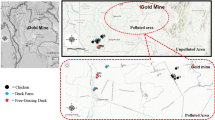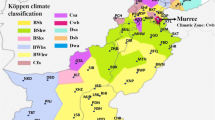Abstract
The cross-sectional study of heavy metals and aflatoxins was conducted by studying duck egg, blood, liver, feed, and water samples from 11 free grazing farms. The duck feed, soil, and rice samples were lower than the standard limit for aflatoxins at 20 ng g−1. The highest levels of aflatoxin were detected in the liver, intestine, and egg yolk; these were 3.04, 1.73, and 4.56 ng g−1 respectively, while the average levels were 1.6 ± 0.73, 1.31 ± 0.23, and 1.87 ± 0.99 ng g−1, respectively. Interestingly, aflatoxin was not detected in any of the egg white albumin samples (90/90 samples), whereas aflatoxin contamination was predominantly found in the yolk. Additionally, the means and standard deviations of Pb and Cd found in the duck eggs were 118.61 ± 22.25 and 13.84 ± 9.06 ng g−1 respectively. The maximum levels of Pb and Cd in eggs were 134.34 and 29.72 ng g−1, respectively. Moreover, Pb contamination occurred in the duck liver tissue in 93.61% (88/94) of the samples, whereas Cd contamination was found in 100% (100/100). The maximum levels of Pb and Cd in the duck liver tissues were 606.16 and 22,946.20 ng g−1, which was higher than those in the eggs. Pb contamination in the water from rice paddy fields after grazing was significantly higher than that in water samples taken before grazing. This is the first report of Pb and Cd contamination in blood, egg, and liver samples of free grazing ducks in Thailand.

Similar content being viewed by others
References
Holt PS, Davie RH, Dewulf J, Gast RK, Huwe JK, Jones DR, Waltman D, Willian KR (2011) The impact of different housing systems on egg safety and quality. Poult Sci 90:251–262
Saito M, Tsuruta O (1993) A new variety of A. Flavas from tropical soil in Thailand and its aflatoxin productivity. Proc Jpn Assoc Mycotoxicol 37:31–36
Williams DE (2012) The rainbow trout liver cancer model: response to environmental chemicals and studies on promotion and chemoprevention. Comp Biochem Physiol C Toxicol Pharmacol 155:121–127
Magnussen A, Pasi MA (2013) Afltoxins, hepatocellular carcinoma and public health. World J Gastroenterol 19:1508–1512
Herzallah SM (2013) Aflatoxin B1 residues in eggs and flesh of laying hen fed aflatoxin B1 contaminated diet. Am J Agri Biol Sci 8:156–161
Abdullah MIM, Nanal MA, Dawoud AS, Marouf HA (2008) Occurrence of afltoxins in table eggs sold in Damietta city regarding its health significance. J Egypt Med Vet Assoc 68:1–12
Stine KE, Brown TM (eds) (2006) Principles of toxicology, 2nd edn. CRC Press, Taylor & Francis Group, Boca Raton, FL, USA, pp 324–333
Sharma B, Singh S, Siddiqi NJ (2014) Review: Biomedical implication of heavy metals induced imbalances in redox systems. Biomed Res Int, Article ID 640754
Abdullah M, Fasola M, Muhammad A, Malik SA, Bostan N, Bokhari H, Kamran MA, Shafqat MN, Alamdar A, Khan M, Ali N, SAMAS E (2015) Avian feathers as a non-destructive bio-monitoring tool of trace metals signatures: a case study from severely contaminated areas. Chemosphere 119:553–561
Kim KH, Kabir E, Jahan SA (2016) A review on the distribution of Hg in the environment and its human health impacts. J Hazard Mater 306:376–385
Almela C, Algora S, Benito V, Clemente MJ, Devesa V, Suner MA, Velez D, Montoro R (2002) Heavy metal, total arsenic, and inorganic arsenic contents of algae food products. J Agri Food Chem 50:918–923
De Francisco N, Ruiz Troya JD, Agüera EI (2003) Review, Lead and lead toxicity in domestic and free living birds. Avian Pathol 32:3–13
Garcia-Rico L, Leyva-Perez J, Jara-Marini ME (2007) Content and daily intake of copper, zinc, lead, cadmium, and mercury from dietary supplements in Mexico. Food Chem Toxicol 45:1599–1605
Ikem A, Egiebor NO (2005) Assessment of trace elements in canned fishes (mackerel, tuna, salmon, sardines and herrings) marketed in Georgia and Alabama (United States of America). J Food Compost Anal 18:771–787
Van Hook R (1978) Transport and transportation pathways of hazardous chemicals from solid waste disposal. Environ Health Perspect 27:295–308
Tsipoura N, Burger J, Newhouse M, Jeitner C, Gochfeld M, Mizrahi D (2011) Lead, mercury, cadmium, chromium, and arsenic levels in eggs, feathers, and tissues of Canada geese of the New Jersey Meadowlands. Environ Res 111:775–784
NMAM (NIOSH Manual of Analytical Methods) (2014). Fourth Edition, 8/15//1994. IOP Publishing Physics Wep. http://www.cdc.gov/niosh/docs/2003-154/pdfs/8005.pdf. Accessed 15 July 2014
EPA (Environmental Protection Agency) (1996) Method 3050B (SW-846): acid digestion of sediments, sludges, and soil revision 2. IOP Publishing PhysicsWep. http://www.epa.gov/sam/pdfs/EPA-3050b.pdf, Accessed 23 May 2014
Gathumbi JK, Usleber E, Agatia TA, Kanqethe EK, Märtlbauer E (2003) Application of immunoaffinity chromatography and enzyme immunoassay in rapid detection of aflatoxin B1 in chicken liver tissues. Poult Sci 82:585–590
Hintze J (2009) NCSS 2007. [Computer Program]. NCSS, LLC, Haysville, Utah, USA
Muangsrichan N, Bejjapong W, Karnpanich W, Pattanakulanun P (2009) Aflatoxin contamination in commercial red curry paste sold in fresh markets. KKU Sci J 37:221–230
Tulayakul P, Boonsoongnern A, Kasemsuwan S, Ratanavanichrojn N, Netvichian R, Khaodhiar S (2012) Heavy metals, Escherichia coli and Salmonella spp. in feeds, reused water, wastewater and manure from swine farms: a case report. Agri Nat Reso 46:882–893
Makaroon T, Kasemsuwan S, Ratanavanichrojn N, Hananantachai H, Mingkhwan R, Khaodhiar S, Tulayakul P (2013) Critical factors on chemical properties and heavy metals in water for livestock farms in Thailand. TJVM 43:581–588
Waegeneers N, De Steur H, De Temmerman L, Van Steenwinkel S, Gellynck X, Viaene J (2009) Transfer of soil contaminants to home-produced eggs and preventive measures to reduce contamination. Sci Total Environ 407:4438–4446
Eisler R (1987b) Lead hazards to fish, wildlife and invertebrates: a synoptic review. Contaminant Hazard Review Report No. 14. U.S. Fish and Wildlife Service. Patuxent Wildlife Research Center Laurel. MD
Waegeneers N, Hoenig M, Goeyens L, De Temmerman L (2009) Trace elements in home-produced eggs in Belgium: levels and spatiotemporal distribution. Sci Total Environ 407:4397–4402
Friend M (1989) Lead poisoning: the invisible disease. U.S. Fish and Wildlife leaflet 13. Washington DC: pp. 5
Pain DJ (1996) Lead in waterfowl. In: Beyer WN, Heinz GH, Redmon-Norwood AW, (eds.), Environmental contaminants in wildlife—interpreting tissue concentrations. Lewis Publishers, Boca Raton, FL: pp. 225–264
Dżugan M, Lis M (2016) Cadmium-induced changes in hatchability and in the activity of aminotransaminases and selected lysosomal hydrolases in the blood plasma of Muscovy ducklings (Cairina moschata). Acta Vet Hung 64:239–249
Dżugan M, Zielinska S, Heclik J, Pieniaze M, Szostek M (2012b) Evaluation of heavy metals environmental contamination based on their concentrations in tissues of wild pheasant (Phasianus colchicus L.) JMBFS 2:238–245
Sarkar A, Ravindran G, Krishnamurty V (2013) A brief review on the effect of cadmium toxicity. IJBT 3:17–36
Dalenberg JW, Van Driel W (1990) Contribution of atmospheric deposition to heavy metal concentrations in field crops. NJAS 38:369–379
De Temmerman L, Hoenig M (2004) Vegetable crops for biomonitoring lead and cadmium deposition. J Atmos Chem 49:121–135
Nutritional values of the egg. (2018). http://www.saudereggs.com/eggnutritionalvalue.htm. Accessed 4 February 2018
Bintvihok A, Thiengnin S, Doi K, Kumagai S (2002) Residues of aflatoxins in the liver, muscle and eggs of domestic fowls. J Vet Med Sci 64:1037–1039
Funding
This work was supported by the Center for Duck Health Science, Kasetsart University, and the Thailand Research Fund (TRF) under Grant No. RDG5320029.
Author information
Authors and Affiliations
Corresponding author
Rights and permissions
About this article
Cite this article
Tulayakul, P., Mingkhwan, R., Hananantachai, H. et al. Heavy Metal (Cd and Pb) and Aflatoxin Contamination in Tissues and Eggs from Free Grazing Ducks and Their Environment in Central Thailand. Biol Trace Elem Res 186, 514–520 (2018). https://doi.org/10.1007/s12011-018-1321-2
Received:
Accepted:
Published:
Issue Date:
DOI: https://doi.org/10.1007/s12011-018-1321-2




